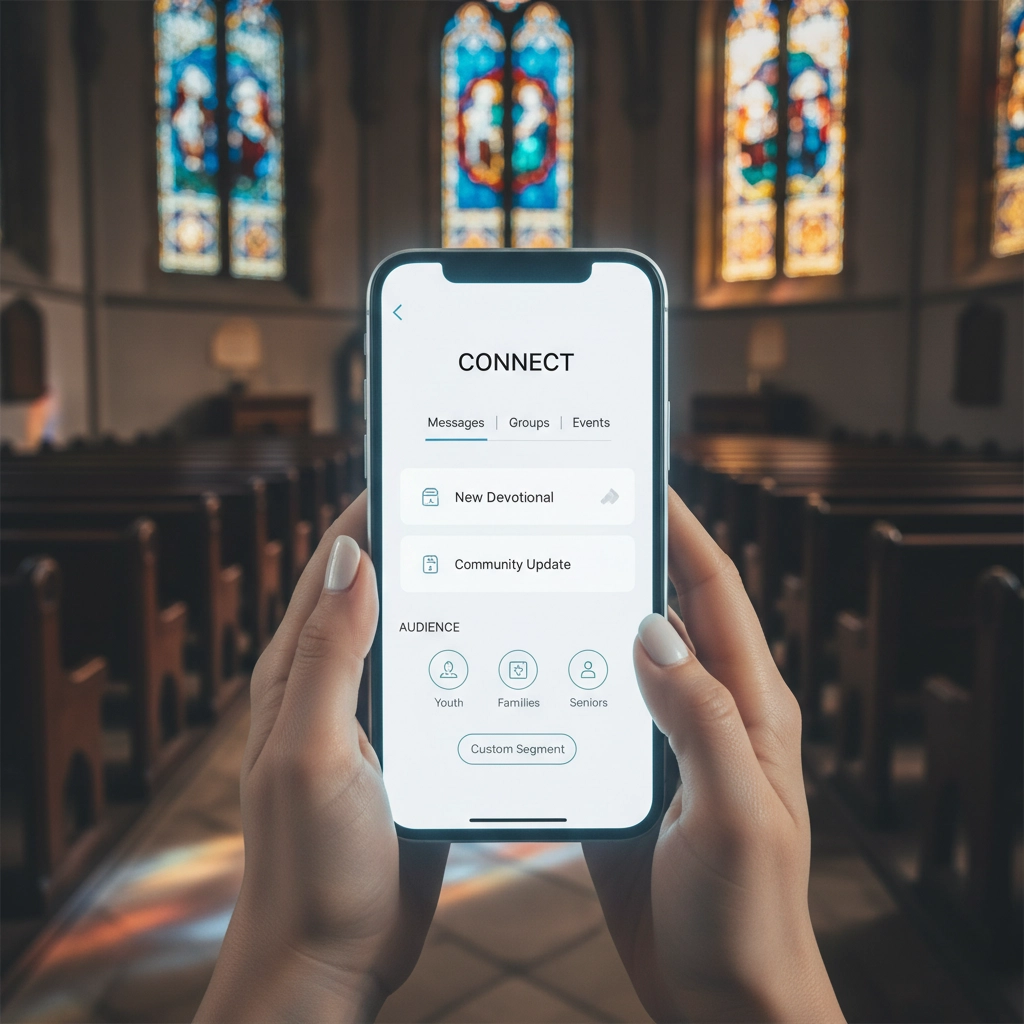Personal connection drives everything in ministry. Whether you're reaching out to someone curious about faith, encouraging a long-time member, or equipping a ministry leader, the right message at the right time can transform lives. But crafting personalized messages for hundreds or thousands of people? That used to mean late nights and endless hours of writing.
Not anymore. AI-powered personalization lets you create meaningful, tailored messages that speak directly to each person's heart and circumstances. You can maintain that personal touch while reaching more people than ever before. Here's how to set up a system that works for your unique ministry context.
Step 1: Define Your Three Core Audiences
Before you write a single message, you need to understand who you're talking to. Your ministry likely serves three distinct groups, each with different needs and communication preferences.
Seekers are people exploring faith, visiting your church for the first time, or asking big questions about life and spirituality. They might feel uncertain, curious, or even skeptical. They need messages that feel welcoming, non-threatening, and focused on answering their questions rather than pushing them toward a decision.
Members are your regular attendees, volunteers, and committed congregation members. They're already part of your community but need encouragement, spiritual growth opportunities, and connection with fellow believers. Their messages should feel like family conversations – warm, supportive, and focused on deepening their faith journey.
Leaders include your staff, volunteers, small group leaders, and ministry team members. They're thinking about serving others, leading effectively, and growing in their roles. They need messages that equip, inspire, and provide practical resources for their ministry responsibilities.

Take time to create detailed profiles for each group. What are their biggest challenges? What language do they use when talking about faith? What questions keep them up at night? The more specific you get, the better your AI will understand how to communicate with each audience.
Step 2: Map Their Spiritual Journeys
Each audience sits at different points in their spiritual journey, and your messages need to meet them exactly where they are. Think about this like creating a roadmap of someone's experience with your ministry.
Seekers typically move through curiosity, exploration, and initial connection phases. Early messages might focus on answering common questions about faith, sharing personal stories, or simply letting them know they're welcome. As they engage more, you can share deeper content about what it means to follow Jesus or get involved in community life.
Members have their own journey from new believer to mature disciple to potential leader. Your messages might progress from basic spiritual practices to more complex theological concepts, from receiving care to giving it, from being served to serving others.
Leaders need ongoing development at every stage of their ministry involvement. Whether they're brand new volunteers or seasoned ministry veterans, they need encouragement, training resources, and connection with other leaders facing similar challenges.
Understanding these journey stages helps you create message sequences that feel natural and helpful rather than random or pushy.
Step 3: Choose the Right AI Tools for Ministry
Not all AI platforms work well for ministry communication. You need tools that understand the nuanced, relationship-focused nature of church work. Look for platforms that can integrate with your existing church management system and handle the complexity of multiple audience segments.
The best AI tools for ministry personalization offer several key features. They should connect with your church database to pull in attendance history, volunteer involvement, and communication preferences. They need to handle different message types – from casual text messages to formal emails to social media posts.

Many successful churches use AI platforms that can analyze individual engagement patterns. If someone always opens emails about family ministry but ignores missions updates, the AI learns to prioritize family-focused content in their messages. If a leader consistently engages with leadership development resources, they'll receive more training opportunities and fewer general announcements.
Set up your AI integration carefully. Create clear boundaries around what information the AI can access and use. Establish approval workflows for sensitive communications like pastoral care messages or difficult announcements. Remember, AI should enhance your personal ministry approach, not replace the human touch that makes ministry relationships special.
Step 4: Create Smart Message Templates
This is where the magic happens. Instead of writing generic prompts, you'll create detailed instructions that help your AI craft messages that sound authentically like your ministry voice while addressing each audience's specific needs.
For seekers, your AI prompts might include instructions like: "Write a welcoming message that acknowledges their courage in exploring faith. Use conversational language and avoid church jargon. Include one practical next step they can take if they're interested, but don't pressure them. Keep the tone warm and non-threatening."
Member messages require different guidance: "Create an encouraging message that celebrates their commitment to the community. Reference specific ways they've contributed recently if that information is available. Include opportunities for deeper involvement or spiritual growth. Use language that assumes they understand basic Christian concepts but explain anything that might be unclear."
Leader communications need yet another approach: "Craft a message that recognizes their service and the challenges they face in ministry. Include practical resources or training opportunities relevant to their role. Acknowledge the spiritual and emotional demands of leadership. Use language that speaks to their heart for ministry while providing concrete help."

Build variety into your templates. Create different message styles for different occasions – welcome sequences, follow-up communications, event invitations, spiritual encouragement, and practical announcements. The more templates you develop, the more natural and varied your AI-generated messages will feel.
Step 5: Test, Learn, and Continuously Improve
AI-powered personalization works best when you treat it as an ongoing conversation rather than a one-time setup. Start by testing your messages with small groups from each audience segment. Send personalized communications to a handful of seekers, members, and leaders, then pay attention to their responses.
Track meaningful metrics beyond just open rates and clicks. Are seekers actually taking the next steps you suggest? Do members feel more connected to community life after receiving your messages? Are leaders using the resources you share and growing in their roles?
Listen to the language people use when they respond to your messages. If seekers consistently ask questions you didn't anticipate, update your AI prompts to address those concerns proactively. If members seem confused by certain references or concepts, adjust your messaging to be clearer. If leaders want different types of resources than you're providing, modify your templates accordingly.
Pay special attention to the personal touch. AI should never completely replace human connection in ministry. Use your AI-generated messages as starting points, then add personal notes when appropriate. If someone's going through a difficult time, don't just send an automated encouragement message – follow up personally or have a pastor reach out directly.

Regular optimization keeps your system fresh and effective. Monthly review sessions help you spot trends, update audience profiles as people grow in their faith journeys, and refine your message templates based on real responses from real people.
Making It Work for Your Ministry
AI-powered personalization isn't about replacing the personal relationships that make ministry meaningful. It's about giving you more time and energy to focus on those relationships while ensuring everyone in your community receives relevant, helpful communication.
Start small with one audience segment and one type of message. Maybe begin with welcome sequences for new visitors or encouragement messages for volunteers. As you see what works, expand to other audiences and message types.
Remember that technology serves people, not the other way around. Your AI should make ministry communication more personal and effective, not more complicated or impersonal. When someone receives a message that speaks directly to their spiritual needs and life circumstances, they feel seen and valued – which is exactly what good ministry accomplishes.
The goal is creating communications that help people take their next steps in faith, feel connected to your ministry community, and grow into the people God created them to be. AI just helps you do it more consistently and effectively for more people than you ever could manually.
With these five steps, you'll build a personalization system that serves your ministry's unique mission while treating each person as the individual they are. That's technology worth celebrating.

